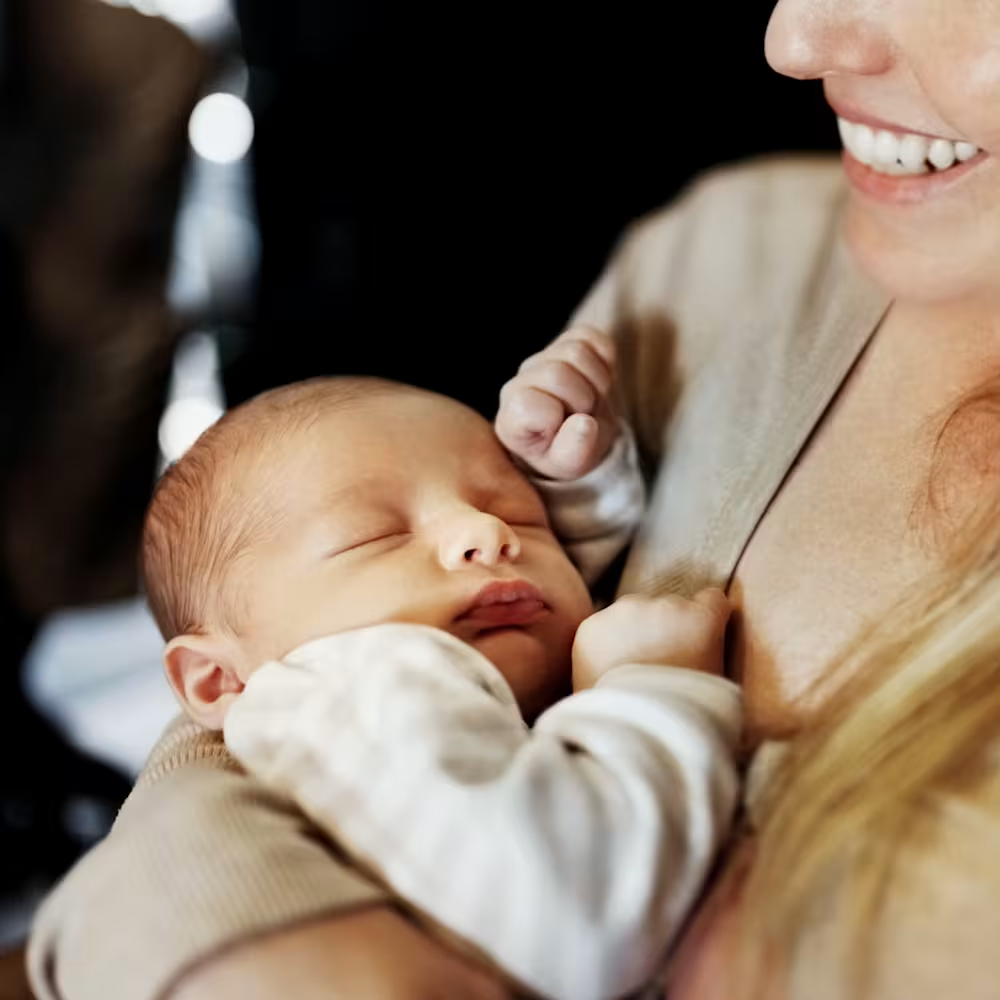Gentle sleep training: Changing routines with minimal tears
Updated Nov 17, 2025

“Gentle” sleep training typically refers to gradual, responsive methods that help babies learn to fall asleep more independently. These approaches focus on consistency, comfort, and small changes over time rather than abrupt shifts. While some crying is normal as routines change, the goal is to support your baby through the process so they feel safe and cared for while learning new sleep habits.
How gentle sleep training differs from “cry it out”
While the focuses on giving babies space to learn self-soothing independently, gentle sleep training methods take a slower, more responsive approach. Both can help babies develop strong sleep skills. The difference lies in how much hands-on support caregivers provide along the way.
Each approach aims to help babies connect sleep cues with comfort and predictability, whether parents stay close or give a bit more space. Common gentle sleep training methods include []:
Fading: Gradually reducing your involvement over several nights, such as shortening the time you spend rocking or patting your baby.
Chair method: Sitting near your baby’s crib during bedtime and slowly moving farther away over time.
Pick up/put down: Comforting your baby with brief pick-ups, then returning them to their sleep space once they’ve calmed.
There’s also a middle ground. Check and console (or timed check-ins like the ) approaches fall somewhere between “gentle” methods and full CIO extinction. Parents briefly check in to reassure their baby at set intervals — either by staying in the room or stepping out and returning — while still allowing some space for independent settling.
Signs your family is ready for gentle sleep training
Every family’s timeline looks different, but gentle sleep training tends to work best when both you and your baby are ready — developmentally and emotionally. Here’s what to look for before easing into a new routine.
Developmental signs your baby is ready
You can always practice healthy sleep habits — like consistent routines, calm environments, and giving your baby small opportunities to settle — right from the start. What changes with age is your expectation for how much independence your baby can handle and how quickly progress happens.
Before deciding to implement “gentle” sleep training, it helps to know what signs suggest your baby’s body and brain are becoming ready for longer stretches of independent sleep:
Age and sleep maturity: Most babies start around 3 - 5 months old, once night feedings naturally begin to space out and their sleep architecture has matured. At 3 - 5 months, results often vary — think of this stage as practice, not mastery.
Emerging self-soothing skills: By , most babies can consistently calm themselves with familiar sleep cues and routines.
Established bedtime routine: Your baby is used to a before sleep (like feeding, changing, dimming lights, and a final cuddle) which helps them recognize that it’s time to rest.
Following an age-appropriate schedule: Your baby’s wake times and naps are starting to fall into a rhythm — whether guided by wake windows or a clock-based routine — making it easier to time sleep when they’re truly ready to rest.
Gentle sleep training can then focus on helping your baby fall asleep the same way at the start of the night.
Emotional signs you’re ready
Gentle sleep training depends on your readiness, too. These signs can help you gauge if you’re in the right headspace to begin:
You’re ready for more calm and predictability: You’d like bedtime to feel smoother, but you still want to offer comfort and reassurance along the way..
You know progress takes time: Gentle methods work best when you can be patient with the ups and downs and celebrate small wins along the way.
You feel grounded enough to stay consistent: You can handle some tears without panic, knowing they’re part of learning — and that you’re supporting your baby through every step.
Popular gentle sleep training methods
There’s no single “right” way to do gentle sleep training. It’s about finding what works best for your baby’s temperament and your family’s comfort level. These share a focus on responsiveness, consistency, and small, gradual changes that build independence.
Pick-up put-down method
This method involves picking your baby up when they cry, soothing them until they’re calm, and then placing them back in their crib while still awake []. It helps babies connect their sleep space with comfort and reassurance while practicing self-soothing in short, manageable bursts. It can take time and patience, but the repeated pattern builds trust and predictability.
Chair method (gradual withdrawal)
With this method, you sit in a chair next to your baby’s crib during bedtime and slowly move farther away over several nights []. Your presence offers comfort and reassurance while your baby learns to settle more independently. Consistency helps your baby understand what to expect and builds confidence in falling asleep on their own.
Fading method
The fading method works by gradually reducing your level of involvement in your baby’s bedtime routine. You might start by rocking, patting, or singing, then slowly do a little less each night. As your baby learns to fall asleep more independently. Because changes are gentle and predictable, this approach often suits families who prefer a gradual, low-stress transition.
Scheduled awakenings
For babies who still wake often at night, this method involves preemptively waking them for a brief feeding or soothing session slightly before their typical wake-up times, then gradually spacing those intervals out []. It can help reset your baby’s internal rhythms and reduce frequent awakenings over time, if they typically wake up around the same times overnight. Gentle consistency and responsiveness are what make this method effective — not rigidity.
Getting started
Every gentle sleep training journey looks a little different, but a calm, consistent rhythm is what helps it work. Here’s a simple framework to guide you:
Start with a soothing bedtime routine: Dim the lights, read a short book, or sing a lullaby. Quiet, predictable cues tell your baby it’s time to wind down.
Set up a comfortable sleep environment: Keep the room dark, cool, and calm. White noise can help signal “sleep time” and minimize sudden awakenings from household noise.
Choose your gentle sleep training method: Pick an approach — like fading or the chair method — and stick with it for at least a week before reassessing.
Respond consistently: Babies thrive on predictability. Offer comfort when needed, but try to keep your responses steady from night to night.
Track patterns and progress: Keep an eye on sleep cues, nap timing, and awakenings by tracking in the . Small improvements add up over time.
If you’re looking for step-by-step support tailored to your baby’s unique sleep habits, our Premium sleep plans offer personalized, in-depth guidance from pediatric sleep experts, so you don’t have to figure it out alone.
Gentle sleep training tips by age
Your baby’s through the first two years, so “gentle” will look a little different at every stage. From short newborn naps to toddler boundary-testing, understanding what’s developmentally normal can help you keep expectations — and your approach — realistic.
3 - 5 months
At 3 - 5 months, your baby’s sleep cycles are maturing, but patterns can still vary widely. This stage is about practice, not perfection — laying the groundwork for healthy sleep habits rather than expecting full independence. Focus on short, consistent bedtime routines, following age-appropriate wake windows and offering gentle opportunities for your baby to settle drowsy but awake.
6 - 11 months
As babies become more mobile and aware, they may start waking for longer periods as they master developmental milestones. Begin gentle sleep training at bedtime, when your baby is naturally most tired and better able to practice settling independently. Methods like the fading or chair approach can help you gradually reduce hands-on support while keeping your baby comforted and secure. Keep bedtime routines consistent, and offer extra reassurance if separation anxiety starts to surface.
12 - 24 months
Toddlers are famous for testing limits — especially at bedtime. As their independence and imagination grow, it’s common for them to resist sleep. A slightly longer, predictable bedtime routine and an age-appropriate bedtime can make gentle sleep training easier.Offer structured choices (“two songs or one tonight?”) and stay consistent with boundaries. Comfort, routine, and clear expectations help toddlers feel secure enough to settle.
24 months and older
By now, many children have consistent routines and have developed independent sleep skills, but regressions can still pop up with big changes like potty training, new siblings, or moving to a bed. Continue to keep bedtime calm and predictable, use gentle reminders, and give extra reassurance during transitions. Gentle methods at this age focus on reinforcing the sleep habits you’ve already built.
Age range | Gentle sleep focus | Caregiver tips |
3 - 5 months | Establish routines and practice falling asleep independently | Introduce a short, soothing bedtime routine (dim lights, soft sounds, and quiet cuddles). Follow sleep cues and wake windows and give your baby chances to fall asleep independently, before they’re . |
6 - 11 months | Encourage self-soothing with reassurance | Try a gradual method like fading or the chair approach, offering comfort without fully restarting the bedtime process each time your baby stirs. Stay consistent — predictability helps babies feel secure. |
12 - 24 months | Balance independence and connection | as they gain autonomy. Offer choices (“two stories or one?”) and use familiar routines to provide structure and reassurance during transitions. |
24 months and older | Reinforcing healthy sleep habits and boundaries | Keep bedtime routines calm and consistent, even through or big changes. Use gentle reminders and plenty of comfort to help your child settle back into sleep. |
When to talk to your pediatrician
Most sleep struggles can be worked through with time, consistency, and a little creativity. Still, it’s always a good idea to check in with your baby’s healthcare provider if something feels off or progress has stalled. Trust your intuition.
Reach out to your pediatrician if you notice:
Loud snoring, gasping, or pauses in breathing during sleep [].
Frequent nighttime wakings or restlessness paired with fussiness or poor feeding [].
Developmental or growth concerns, such as not meeting expected milestones [].
When to get personalized sleep help
If you’ve ruled out medical issues and still feel stuck, can offer step-by-step guidance tailored to your child’s age, temperament, and sleep habits. Our sleep experts can help you find solutions that fit your family’s needs, without the guesswork.
Takeaway
Gentle sleep training focuses on connection and consistency. It’s about helping your baby learn healthy sleep habits through comfort and predictability — not perfection.
Tears are normal. Gentle methods aim to minimize crying, not eliminate it entirely. Your calm, steady presence helps your baby feel safe while learning new skills and tears depend on your child’s temperament and parental consistency.
Every family’s timeline looks different. Readiness depends on both your baby’s development and your own comfort level. Go at a pace that feels right for everyone.
You don’t have to do it alone. If you’d like more personalized support, Huckleberry’s Premium Sleep Plans offer step-by-step guidance tailored to your baby’s age, temperament, and your parenting preferences.
Gentle sleep training FAQ
Share article:
Note: The content on this site is for informational purposes only and should not replace medical advice from your doctor, pediatrician, or medical professional. If you have questions or concerns, you should contact a medical professional.






